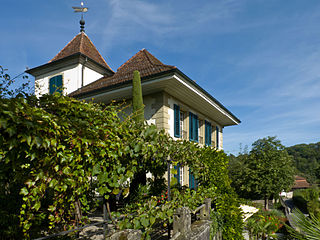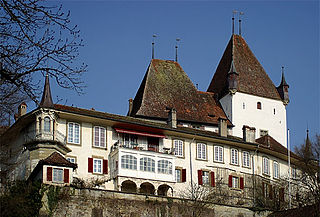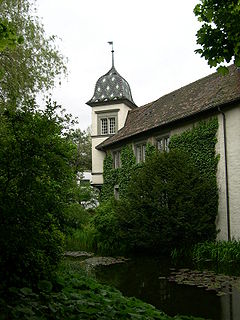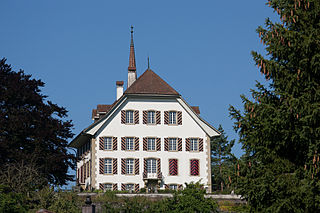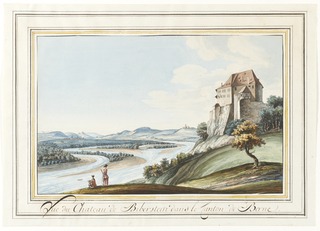History
The construction date of Toffen Castle is unknown. It first appears in a record on 19 May 1306 when Johann von Bremgarten gave up his estates, which included Toffen and Bremgarten Castles, to his uncles Heinrich and Ulrich von Bremgarten. In 1323 Peter von Gysenstein, a patrician from Bern, acquired the castle and Zwing und Bann right over the villagers of Toffen. The castle was inherited, through his daughter, by Johann Senn von Münsingen. In 1352 Ulrich "Keseli" von Toffen, a local noble, bought part of the estate. Three years later, he bought the remainder. His family held the castle and surrounding estates for almost one hundred years. [2]
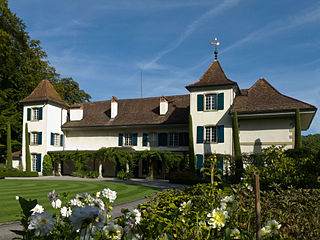
Bremgarten Castle is a castle in the municipality of Bremgarten of the canton of Bern in Switzerland. It is a Swiss heritage site of national significance.
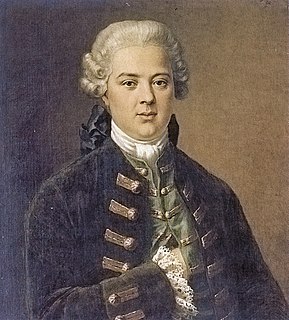
Patricianship, the quality of belonging to a patriciate, began in the ancient world, where cities such as Ancient Rome had a class of patrician families whose members were initially the only people allowed to exercise many political functions. In the rise of European towns in the 12th and 13th century, the patriciate, a limited group of families with a special constitutional position, in Henri Pirenne's view, was the motive force. In 19th century central Europe, the term had become synonymous with the upper Bourgeoisie and can't be compared with the medieval patriciate in Central Europe. In the German-speaking parts of Europe as well as in the maritime republics of Italy, the patricians were as a matter of fact the ruling body of the medieval town and particularly in Italy part of the nobility.

Bern or Berne is the de facto capital of Switzerland, referred to by the Swiss as their "federal city", in German Bundesstadt, French ville fédérale, and Italian città federale. With a population of about 140,000, Bern is the fifth-most populous city in Switzerland. The Bern agglomeration, which includes 36 municipalities, had a population of 406,900 in 2014. The metropolitan area had a population of 660,000 in 2000. Bern is also the capital of the canton of Bern, the second-most populous of Switzerland's cantons.
After passing through several additional owners, in 1507 Bartholomew May (1446-1531) bought the estate. According to tradition, after the Battle of Novara, Bartholomew May brought the first bears to Bern's Bärengraben or Bear Pit. Bartholomew expanded and renovated the old castle into a late Gothic country manor house. [3] The castle stayed in the von May family until 1610 when it was sold to Loys or Elogius Knobloch.

The Battle of Novara was a battle of the War of the League of Cambrai fought on 6 June 1513, near Novara, in Northern Italy. A French attacking force was routed by allied Milanese–Swiss troops, the consequence of which was that France was forced to withdraw entirely from Italy.

The Bärengraben, or Bear Pit, is a tourist attraction in the Swiss capital city of Bern. It is a bear pit, or enclosure housing bears, situated at the eastern edge of the old city of Bern, next to the Nydeggbrücke and the River Aar. Although still in use, the Bärengraben has been supplemented since 2009 by the adjacent BärenPark, a larger and more natural enclosure alongside the River Aar.

Gothic architecture is a style that flourished in Europe during the High and Late Middle Ages. It evolved from Romanesque architecture and was succeeded by Renaissance architecture. Originating in 12th-century France, it was widely used, especially for cathedrals and churches, until the 16th century.
Knobloch brought in carpenters and artists from the Alsace region to renovate the castle interior. The Bretzelistube still contains the rich Renaissance style carvings as well as later paintings by the Bernese artist Joseph Werner. Loys Knobloch's daughter from his first marriage, Anna, married Abraham von Werdt in 1616. After the death of her father in 1642, von Werdt became the Freiherr over Toffen. The Toffen branch of the von Werdt family owned the castle for nine generations and today it is owned by Mrs. von May-von Werdt, who combines two family lines with extensive history at Toffen Castle. [2]

Alsace is a cultural and historical region in eastern France, on the west bank of the upper Rhine next to Germany and Switzerland.

Renaissance architecture is the European architecture of the period between the early 14th and early 16th centuries in different regions, demonstrating a conscious revival and development of certain elements of ancient Greek and Roman thought and material culture. Stylistically, Renaissance architecture followed Gothic architecture and was succeeded by Baroque architecture. Developed first in Florence, with Filippo Brunelleschi as one of its innovators, the Renaissance style quickly spread to other Italian cities. The style was carried to France, Germany, England, Russia and other parts of Europe at different dates and with varying degrees of impact.

Joseph Werner, known as the Younger to distinguish him from his painter father of the same name, was a Swiss painter, known for miniatures.
In 1671-73 Johann Georg von Wendt rebuilt the entire castle into a Baroque manor. He removed an entire story from the main building and replaced the roof. The old curtain wall and gate house was demolished. An elegant garden replaced the old courtyard. A western wing was added to castle, with a great dining hall. He commissioned the popular Bernese landscape painter, Albrecht Kauw to paint four paintings that depicted the "Castle and Lands of Toffen" in each of the four cardinal directions. [2] Around 1750 Georg Samuel von Werdt expanded and renovated the castle again. [3]

A curtain wall is a defensive wall between two towers (bastions) of a castle, fortress, or town.

Albrecht Kauw (1621–1681) was a Swiss still-life painter, cartographer and a painter of vedute.
Following the 1798 French invasion, and the creation of the Helvetic Republic the owners of the castle lost their medieval rights to rule over, judge and punish the villagers. However, they retained ownership of the castle and it remains in private hands today. [2]
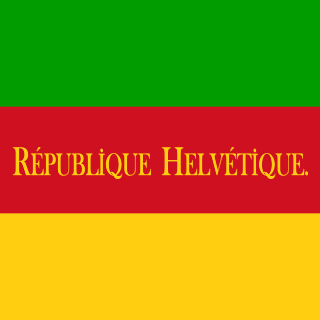
In Swiss history, the Helvetic Republic (1798–1803) represented an early attempt to impose a central authority over Switzerland, which until then had consisted of self-governing cantons united by a loose military alliance.
This page is based on this
Wikipedia article Text is available under the
CC BY-SA 4.0 license; additional terms may apply.
Images, videos and audio are available under their respective licenses.

















